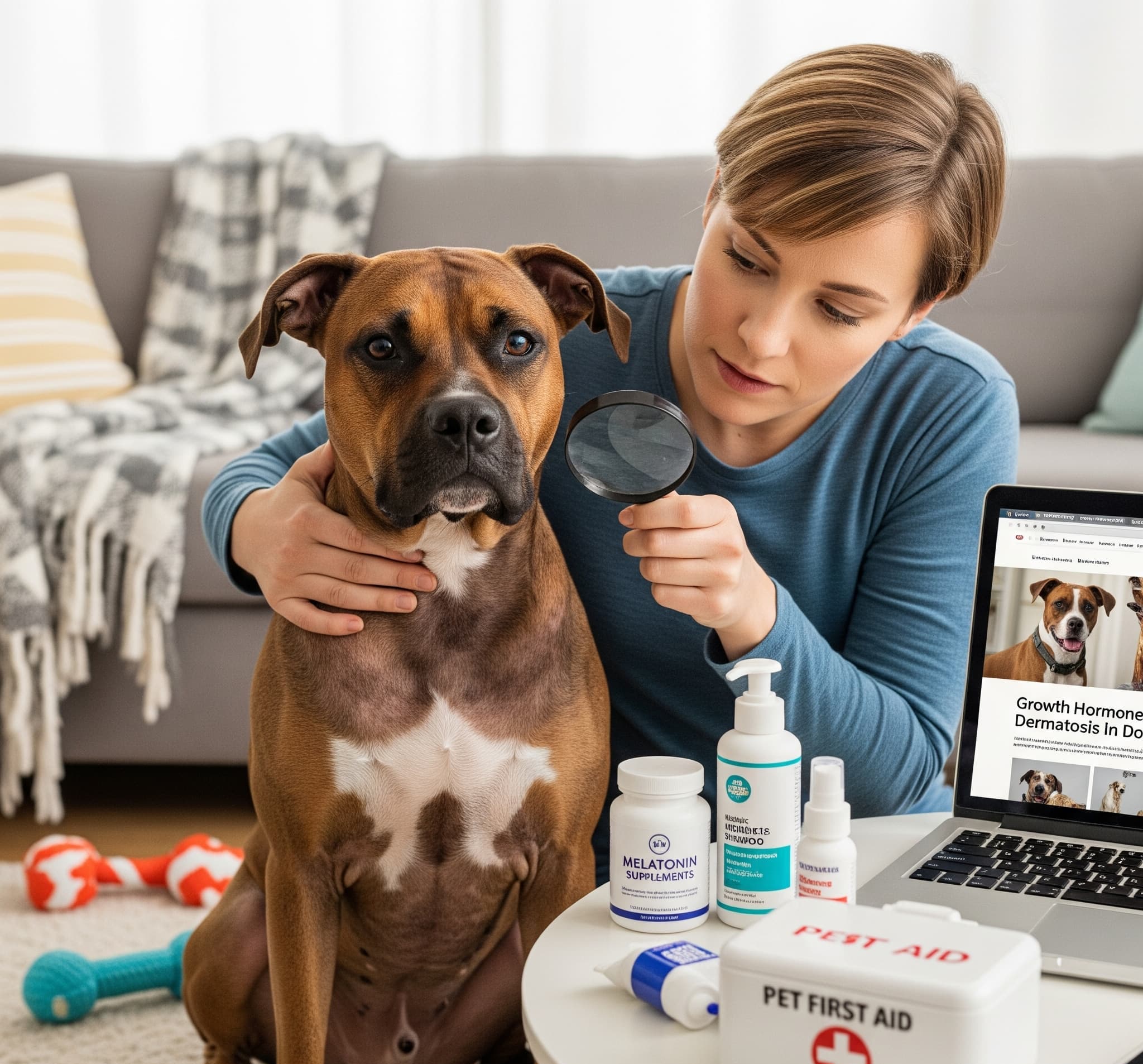Dog Owners Alert: How to Handle Hypocalcemia Crises in Your Hypoparathyroid Pup
Learn quick, reliable ways to handle emergency low-calcium episodes in dogs with hypoparathyroidism- and keep your pet steady over the long haul.
Introduction
Imagine coming home to find your lively dog shivering uncontrollably, legs stiff, breathing faster than normal. That unsettling scene probably means calcium levels in his blood have plummeted. As any careful owner can tell you, hypoparathyroidism turns routine days into crises with surprising speed, and low calcium lies at its heart. The good news is you can act fast and protect your companion, provided you know what to watch for and what to do. This guide walks you through the causes of these episodes, early warning signs, emergency fixes, and steps for stable living afterward. So grab a notebook-and think of this page as your mini field manual for a happier, safer dog.
To help you find the details you need without wading through pages of text, we’ve broken the material into clear sections, each with its own heading and practical tips, bringing ease to both emergencies and everyday care.
- What Is Hypoparathyroidism and Why Does It Cause Hypocalcemia
- Recognising a Hypocalcemia Emergency in Your Dog
- Emergency Actions What to Do Right Away
- Long Term Care for Your Hypoparathyroid Dog
- Frequently Asked Questions
What Is Hypoparathyroidism and Why Does It Cause Hypocalcemia
Hypoparathyroidism may sound technical, yet its essence is simple. Situated near the thyroid, the parathyroid glands release parathyroid hormone (PTH), a key player in maintaining stable calcium levels. When these glands become impaired, PTH production drops and, as a direct consequence, circulating calcium levels plummet. Clinical veterinarians label this condition hypocalcemia.
The most frequent trigger is an immune-mediated attack, in which the dogs own defence system inadvertently damages the parathyroid tissue. Surgical manipulation of the thyroid, a rare but real complication, can sever or excise the glands as well. Congenital forms exist too, albeit infrequently, characterised by pups being born with poorly developed or absent parathyroid structures. Tumours or chronically elevated calcium levels causing gland atrophy represent additional, though uncommon, pathways to the disease.
Think of calcium as the spark plug that keeps a dog’s muscles and nerves humming. When the supply drops, everything misfires: muscles twitch, nerves get jumpy, and movement resembles a car struggling on fumes. Hypocalcemia can hit any breed or age, yet small toys like Poodles and larger types such as German Shepherds appear in more cases.
The problem often tracks back to low Parathyroid Hormone (PTH), which normally pulls calcium from bone and boosts gut absorption. Without enough PTH, calcium leaks away, phosphorus piles up, and the delicate balance collapses. Blood tests reveal total calcium dipping below 9 mg per dL and often plunging lower during serious episodes. The ionized, or usable, form drops under 1 mmol per L.
Although the condition is rare, it strikes hard when it arrives, making prompt recognition vital. The sooner a veterinarian starts treatment, the better the outlook. If twitching, weakness, or odd behavior appears, speak to a vet about blood work. Their lab will clear calcium, phosphorus, and PTH levels and plot a recovery course.
For a brief overview of the causes and signs of hypocalcemia in dogs, take a look at this video. It explains everything in straightforward terms. https://www.youtube.com/watch?v=8hMdPlusOpw
Recognising a Hypocalcemia Emergency in Your Dog
You know your dog better than anyone else- so trust your instincts. When blood calcium levels drop, symptoms can appear suddenly after a quiet period. The first thing you may notice is restlessness: your pet paces, whines, or cannot find a comfortable spot. Next, small muscle twitches show up, often around the face, ears, or eyelids. Give it time and that minor twitch can spread into noticeable tremors through the entire body.
Have you ever caught your dog rubbing her muzzle against the carpet for minutes? Thats a hallmark sign, along with unprovoked low growls. Heavy panting might surprise you, even if the room feels cool. If the crisis deepens, stiffness takes over and walking looks wobbly- vets call that ataxia. Weakness follows, so your dog suddenly struggles to jump onto the sofa or collapses after short trips outside.
The real fear? Seizures or sustained muscle contractions, known as tetany, where legs and jaws lock rock-hard. Temperatures can shoot up because muscles are burning energy like a runaway engine. Some dogs vomit, many lose their appetite. At the same time they drink and urinate more than usual. In chronic cases cloudy cataracts later appear and bones become fragile.
Excitement or exercise can sometimes flip a calm dog into a shaky mess. A game of fetch can quickly escalate into a near-crisis. Ugh, weve all faced those pet scares. Yet, if you spot the warning signs early, you save a life. When calcium dips below 7 mg per dL, symptoms explode.
Not every low-calcium episode points to hypoparathyroidism. Kidney trouble, pancreatitis, or even toxins like antifreeze can mimic the same picture. Still, in hypoparathyroid pups, that underactive parathyroid gland is usually the main villain.
Curious about the signs? This video nails it with real examples. https://www.youtube.com/watch?v=Xx9i922gydk.
Keep a small log of odd behaviors and share it with your vet. Tracking twitching, panting, or any strange tick can help your doctor pinpoint the issue fast.
This section is a quick 320-word read. Short and punchy, just like your pups tail wag.
Emergency Actions What to Do Right Away.
Alright, this is the moment when you spring into action. A hypocalcemia crisis is no joke. Left untreated, it can trigger seizures or heart trouble. First step: breathe. Your dog picks up your mood, so staying calm really matters.
If they are twitching or seizing, gently move them to a soft, quiet spot far from stairs or sharp furniture. Cup your hands around their mouth so they dont bite their tongue, but dont hold them too tight. Watch the clock, because most seizures are over in one or two minutes. If it drags on, call your vet while you keep your pup still and cool.
Phone your veterinarian or the nearest emergency clinic immediately. Explain that you suspect hypocalcemia in a dog with hypoparathyroidism. They can advise you on the safest next steps. Avoid giving any oral calcium at home during an emergency; the absorption is too slow and may worsen the situation.
Once at the hospital, doctors will begin treatment with intravenous calcium gluconate, the established gold standard. The usual dose is 0.5 to 1.5 milliliters per kilogram of a 10 percent solution given slowly over 10 to 30 minutes. The infusion must be gradual to protect the heart, so staff constantly monitor the ECG for changes such as bradycardia or other arrhythmias.
If seizures occur, diazepam can relax the muscles and ease spasms. Be alert for rising body temperature; most cases improve spontaneously once calcium levels climb, yet mild cooling may help if needed.
The immediate aim is not to restore calcium completely, simply to raise it enough to quiet severe signs, usually around 6 to 7 milligrams per deciliter. Correcting faster carries the risk of overcorrection and rebound toxicity.
After the initial bolus, the team may transition to a continuous drip or to subcutaneous injections diluted in saline every 6 to 8 hours.
Most patients stay in hospital one to two days while the blood is checked routinely. Once a stable level is confirmed, owners go home with oral supplements and follow-up appointments.
Think of treatment as recharging a drained battery: bringing power back slowly and steadily prevents surges and protects the system.
This short video shows a veterinarian treating hypocalcemia step by step. Its a handy visual if you want to see the process in action. https://www.youtube.com/watch?v=GNB4neKkTxw
Long-term care for your hypoparathyroid dog
Crisis averted? Fantastic. Now the real work begins: keeping that stable day after day. Ongoing management steadies calcium and stops scary episodes from reopening old wounds. Your vet usually starts with vitamin D, most often in the calcitriol form. It acts quickly, often within one to four days. The initial dose is higher, then the number drops as levels even out.
Next come oral calcium supplements-always the gluconate or lactate versions because they sit easiest in the stomach. Give them during a meal to boost absorption.
Food plays a huge role. Look for recipes or brands that offer high calcium and low phosphorus. Skip treats that pack too much phosphate. If numbers stay high, occasional phosphate binders can help tidy up leftover excess.
Routine check-ups keep you on track. Blood tests every week at first, then monthly after a stable spell. The goal is calcium between 8 and 9 mg per dL. Too much pushes stones in kidneys or soft tissues.
Think of care like tending a garden. Regular watering, weeding, and occasional replanting keep everything growing well.
Some dogs need medication for life, while others stabilize with diet alone. Watch for warning signs, especially vomiting or lethargy, which may mean calcium climbed too high.
Exercise should be gentle. Skip wild games that could trigger a crisis. Also do your best to keep stress low.
With proper care the outlook is bright. Your pup can enjoy a long, happy life.
Frequently Asked Questions
Have a question? You are far from the only owner trying to make sense of this rare condition. To lend a hand, we answer the most common inquiries.
Can my dog recover fully from hypoparathyroidism? Life-long treatment lets most pets thrive. The disease does not disappear, yet signs often fade when care is on point.
How often should I test blood-calcium levels? Weekly checks are wise right after a serious drop. Once things stabilize, your vet will probably swap to every one to three months.
Are there natural remedies for hypocalcemia in dogs? Rely on veterinarian-approved supplements. Plant powders or bone meal may sound gentle, yet they can upset dosing and calcium balance, so always ask first.
What breeds are prone to this condition? Hypoparathyroidism can show up in almost any mix, but miniature poodles, dachshunds, and schnauzers appear more often in the study books.
Is surgery an option for hypoparathyroidism? Surgery is rare. When a tumor causes the problem, it makes sense, yet the majority of cases stem from the immune system, so medicine usually rules.
Conclusion
That was a quick run-through. True, hypoparathyroidism can spark frightening calcium drops, but you are more than able to drive the care car. Watch for signs, give IV calcium when needed, and stay steady with vitamin D and diet. Your dog counts on you, and with this know-how on your side, he will keep wagging for years to come.
Prepared to be proactive? Speak with your veterinarian today about screening whenever your dog exhibits unusual signs. Pass this guide along to other dog owners; it may prove life-saving. And, of course, subscribe to our newsletter for ongoing pet health advice delivered directly to your inbox.




Post Comment